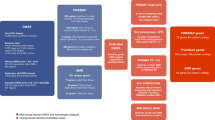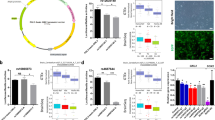Abstract
The sequence and genomic organization of the human Golfα (GNAL) gene were determined. The human GNAL gene was found to contain 12 coding exons, and it spans over 80 kb on chromosome 18p11. 5′ RACE analysis suggested an additional transcription initiation start site. Sequence analysis of the putative promoter region revealed conserved binding sites for several transcription factors. Sequence analysis of the 3′-untranslated region revealed the presence of two Alu sequences and two polyadenylation signals. 3′ RACE analysis confirmed the functionality of the most downstream poly-a signal. The human GNAL was found to be expressed as a single transcript of about 5.9 kb in the brain. One highly informative dinucleotide repeat was found in intron 5. Additionally, a processed pseudogene for asparagine synthetase was found about 6 kb upstream of the GNAL gene. Knowledge of the sequence and structure of the human GNAL gene provides essential information for further analysis of the GNAL locus at chromosome 18p11 which has been linked to bipolar disorder and schizophrenia.
This is a preview of subscription content, access via your institution
Access options
Subscribe to this journal
Receive 12 print issues and online access
$259.00 per year
only $21.58 per issue
Buy this article
- Purchase on Springer Link
- Instant access to full article PDF
Prices may be subject to local taxes which are calculated during checkout





Similar content being viewed by others
References
Gilman AG . G proteins: transducers of receptor-generated signals Annu Rev Biochem 1987; 56: 615–649
Simon MI, Strathmann MP, Gautam N . Diversity of G proteins in signal transduction Science 1991; 252: 802–808
Spiegel AM . G proteins in cellular control Curr Opin Cell Biol 1992; 4: 203–211
Neer EJ . Heterotrimeric G proteins: organizers of transmembrane signals Cell 1995; 80: 249–257
Sprang SR . G protein mechanisms: insights from structural analysis Annu Rev Biochem 1997; 66: 639–678
Hamm HE . The many faces of G protein signaling J Biol Chem 1998; 273: 669–672
Jones DT, Reed RR . Golf: an olfactory neuron specific-G protein involved in odorant signal transduction Science 1989; 244: 790–795
Herve D, Levi-Strauss M, Marey-Semper I, Verney C, Tassin J-P, Glowinski J et al. Golf and Gs in rat basal ganglia: possible involvement of Golf in the coupling of dopamine D1 receptor with adenylyl cyclase J Neurosci 1993; 13: 2237–2248
Zigman JM, Westermark GT, LaMendola J, Boel E, Steiner DF . Human Golf α: complementary deoxyribonucleic acid structure and expression in pancreatic islets and other tissues outside the olfactory neuroepithelium and central nervous system Endocrinology 1993; 133: 2508–2514
Herve D, Rogard M, Levi-Strauss M . Molecular analysis of the multiple Golf α subunit mRNAs in the rat brain Mol Brain Res 1995; 32: 125–134
Frayon S, Pessah M, Giroix MH, Mercan D, Boissard C, Malaisse WJ et al. Galphaolf identification by RT-PCR in purified normal pancreatic B cells and in islets from rat models of non-insulin-dependent diabetes Biochem Biophys Res Commun 1999; 254: 269–272
Ferrand N, Pessah M, Frayon S, Marais J, Garel JM . Olfactory receptors, Golf alpha and adenylyl cyclase mRNA expressions in the rat heart during ontogenic development J Mol Cell Cardiol 1999; 31: 1137–1142
Overhauser J, Mewar R, Rojas K, Lia K, Kline AD, Silverman GA . STS map of genes and anonymous DNA fragments on human chromosome 18 using a panel of somatic cell hybrids Genomics 1993; 15: 387–391
Berrettini WH, Ferraro TN, Goldin LR, Weeks DE, Detera-Wadleigh S, Nurnberger JI Jr et al. Chromosome 18 DNA markers and manic-depressive illness: evidence for a susceptibility gene Proc Natl Acad Sci USA 1994; 92: 5918–5921
Stine OC, Xu J, Koskela R, McMahon FJ, Gschwend M, Friddle C et al. Evidence for linkage of bipolar disorder to chromosome 18 with a parent-of-origin effect Am J Hum Genet 1995; 57: 1384–1394
Schwab SG, Hallmayer J, Lerer B, Albus M, Borrmann M, Honig S et al. Support for a chromosome 18p locus conferring susceptibility to functional psychoses in families with schizophrenia, by association and linkage analysis Am J Hum Genet 1998; 63: 1139–1152
Detera-Wadleigh SD, Badner JA, Berrettini WH, Yoshikawa T, Goldin LR, Turner G et al. A high-density genome scan detects evidence for a bipolar-disorder susceptibility locus on 13q32 and other potential loci on 1q32 and 18p11.2 Proc Natl Acad Sci USA 1999; 96: 5604–5609
Nothen MM, Cichon S, Rohleder H, Hemmer S, Franzek E, Fritze J et al. Evaluation of linkage of bipolar affective disorder to chromosome 18 in a sample of 57 German families Mol Psychiatry 1999; 4: 76–84
Sanger F, Nicklen S, Coulson AR . DNA sequencing with chain-terminating inhibitors Proc Natl Acad Sci USA 1977; 74: 5463–5467
Berrettini WH, Vuoristo J, Ferraro TN, Buono RJ, Wildenauer D, Ala-Kokko L . Human Golf gene polymorphisms and vulnerability to bipolar disorder Psychiatr Genet 1998; 8: 235–238
Bray P, Carter A, Simons C, Guo V, Puckett C, Kamholz J et al. Human cDNA clones for four species of Gαs signal transduction protein Proc Natl Acad Sci USA 1986; 83: 8893–8897
Kozasa T, Itoh H, Tsukamoto T, Kaziro Y . Isolation and characterization of the human Gsα gene Proc Natl Acad Sci USA 1988; 85: 2081–2085
Andrulis IL, Chen J, Ray PN . Isolation of human cDNAs for asparagine synthetase and expression in Jensen rat sarcoma cells Mol Cell Biol 1987; 7: 2435–2443
Greco A, Ittmann M, Basilico C . Molecular cloning of a gene that is necessary for G1 progression in mammalian cells Proc Natl Acad Sci USA 1987; 84: 1565–1569
Zhang YP, Lambert MA, Cairney EL, Wills D, Ray PN, Andrulis IL . Molecular structure of the human asparagine synthetase gene Genomics 1989; 4: 259–265
Sheets MD, Ogg SC, Wickens MP . Point mutations in AAUAAA and the poly(A) addition site: effects on the accuracy and efficiency of cleavage and polyadenylation in vitro Nucleic Acids Res 1990; 18: 5799–5805
Wang MM, Tsai RYL, Schrader KA, Reed RR . Genes encoding components of the olfactory signal transduction cascade contain a DNA binding site that may direct neuronal expression Mol Cell Biol 1993; 13: 5805–5813
Soloyev V, Salamov A . The gene-finder computer tools for analysis of human and model organisms genome sequences Ismb 1997; 5: 294–302
Moyzis RK, Torney DC, Meyne J, Buckingham JM, Wu J-R, Burks C et al. The distribution of interspersed repetitive DNA sequences in the human genome Genomics 1989; 4: 273–289
Chen EY, Liao Y-C, Smith DH, Barrera-Saldana HA, Gelinas RE, Seeburg PH . The human growth hormone locus: nucleotide sequence, biology, and evolution Genomics 1989; 4: 479–497
Edwards A, Voss H, Rice P, Civitello A, Stegemann J, Schwager C et al. Automated DNA sequencing of the human HPRT locus Genomics 1990; 6: 593–608
Carter PE, Duponchel C, Tosi M, Fothergill JE . Complete nucleotide sequence of the gene for human C1 inhibitor with an unusually high density of Alu elements Eur J Biochem 1991; 197: 301–308
Martin-Gallardo A, McCombie WR, Gocayne JD, FitzGerald MG, Wallace S, Lee BM et al. Automated DNA sequencing and analysis of 106 kilobases from human chromosome 19q13.3 Nature Genet 1992; 1: 34–39
McCombie WR, Martin-Gallardo A, Gocayne JD, Fitzgerald M, Dubnick M, Kelley JM et al. Expressed genes, Alu repeats and polymorphisms in cosmids sequenced from chromosome 4p16.3 Nature Genet 1992; 1: 348–353
Yulug IG, Yulug A, Fisher EMC . The frequency and position of Alu repeats in cDNAs, as determined by database searching Genomics 1995; 27: 544–548
Belluscio L, Gold GH, Nemes A, Axel R . Mice deficient in G(olf) are anosmic Neuron 1998; 20: 69–81
Moberg PJ, Agrin R, Gur RE, Gur RC, Turetsky BI, Doty RL . Olfactory dysfunction in schizophrenia: a qualitative and quantitative review Neuropsychopharmacology 1999; 21: 325–340
Acknowledgements
We wish to thank Ms Rohini Dhulipala and Ms Aila Jokinen for excellent technical assistance. This work was supported in part by a grant from the Lucille P Markey Charitable Trust.
Author information
Authors and Affiliations
Corresponding author
Rights and permissions
About this article
Cite this article
Vuoristo, J., Berrettini, W., Overhauser, J. et al. Sequence and genomic organization of the human G-protein Golfα gene (GNAL) on chromosome 18p11, a susceptibility region for bipolar disorder and schizophrenia. Mol Psychiatry 5, 495–501 (2000). https://doi.org/10.1038/sj.mp.4000758
Received:
Revised:
Accepted:
Published:
Issue Date:
DOI: https://doi.org/10.1038/sj.mp.4000758
Keywords
This article is cited by
-
Rare genetic brain disorders with overlapping neurological and psychiatric phenotypes
Nature Reviews Neurology (2024)
-
Identification of candidate genes associated with bacterial and viral infections in wild boars hunted in Tuscany (Italy)
Scientific Reports (2022)
-
A new mutation in the GNAL gene in familial dystonia presenting with mental symptoms
Neurological Sciences (2022)
-
Monosomy 18p
Orphanet Journal of Rare Diseases (2008)
-
Alternative transcripts and evidence of imprinting of GNAL on 18p11.2
Molecular Psychiatry (2005)



